¶ ITG Dance Pads
Playing ITG requires a dance pad. A good dance pad can be hard to come by. This page outlines some options for getting a dance pad for ITG.
This video from 2020 is a bit old, but it outlines many of the options.
¶ Pads that can be bought new
¶ Summary
| Pad | Country | Price (before shipping) | Build Size | Sensor Type | Availability |
|---|---|---|---|---|---|
| LTEK Core | Poland | $282 | Full | Contact | High |
| Born2Lead ITG Replica | China | $1100 | Arcade | Arcade | High |
| yuancon pad | China | $1199 | Arcade | Arcade | High |
| Galaxi Mat EX | United States | $600 | Full | FSR | High |
| Galaxi Mat Mini | United States | $400 | Half | FSR | High |
| FSR Mini Pad - V4 | Netherlands | €590 | Half | FSR | Infrequent |
| BlueCombo Halfpad | Italy | €590 | Half | FSR | Infrequent |
| Pubby Pad | United States | $175 | Hybrid? | FSR | Unknown |
| StepManiaX Stage | United States | $1895 | Arcade | FSR | Rare |
| DSPrototyping Wooden DDR Pad | United States | $300 | Full | Contact | Unknown |
¶ LTEK

LTEK dance pads (also sometimes called "Polish pads") are full-sized pads that are good for both stamina content and tech content. These pads use contact sensors, and may require mods such as the penny-mod to be more sensitive. They cost about $400 shipped to the USA, and less for those in Europe. The pads are easily available, professional, and quite popular.
The current generation pads feature a 1000hz polling rate, which is ideal. Older generation pads unfortunately poll at 125hz, but guides exist that explain how to increase this.
Notable possible downsides include the thin and flexible 2.5mm polycarbonate panels being more prone to cracking than thicker panels, wood screws becoming loose over time (fixed by upgrading to threaded inserts), penny modding performed with coins causing damage to the sensor plates over time (addressed by instead using copper tape, strips, or any other conductive material with a flat surface and no hard raised edges), and the fibreboard base of the pad warping slightly in high humidity environments.
¶ LTEKs may be purchased with a bar kit, but the bar is not very good as it's low in height and wobbly compared to arcade bars. Bar players usually make their own bar out of plumbing pipe. Note that newer LTEK models have sturdier bars than older models, as the metal support brackets were redesigned.
Born2Lead Replica Pad

Born2Lead is a China-based company that produces replicas of arcade pads for $1200, including the ITG2 dedicab build. They also offer other replica hardware, like DDR Solo, 9-panel and Pump pads, as well as EZ2DJ controllers. These pads are built and shipped from China, which will involve a somewhat costly shipping rate and a decent wait time, but even then are relatively inexpensive compared to similar arcade-build options. They've recently stopped shipping the AliExpress EZ2Dancer sensors in their pads because of reports that they're more likely to break (although there haven't been many reports of this within the ITG community), so they only ship Konami sensors from now on.
A lot of people that have shared their experience with these pads have complained about the stock foam. You can actually request to have no foam applied during the order. If you don't already have a foam tape you swear by, you should try some 1 inch wide VHB tape instead.
¶ yuancon pad
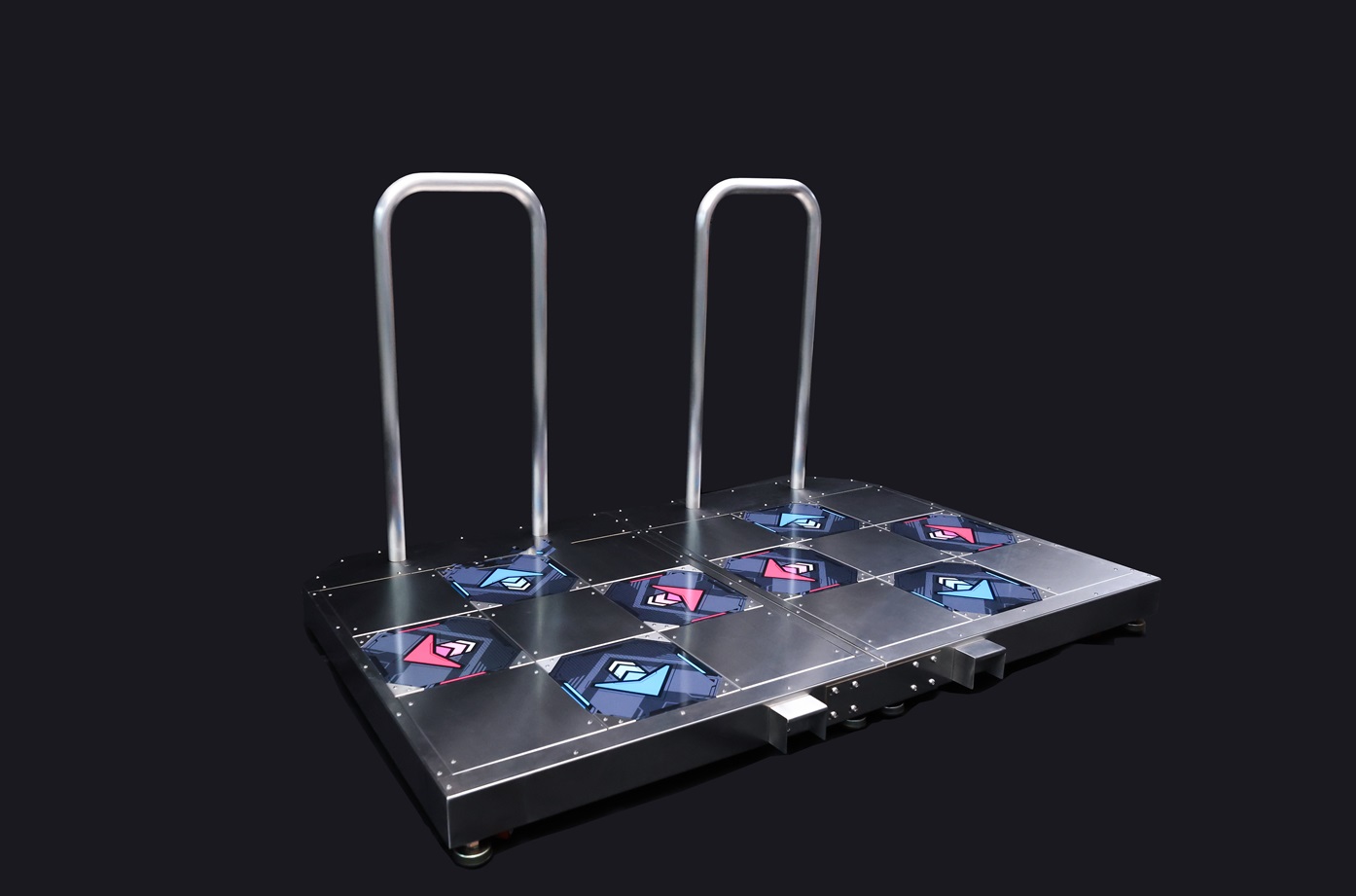
Yuancon is a Chinese rhythm game hobbyist controller building company that produces an interpretated replica of the arcade DDR pads for $1200. Like B2L, they are built and shipped from China. The sensors are glued-together arcade sensors. It looks like the controller chip and firmware could make use of FSRs, but no units have actually been shipped with FSRs as of yet. However, you do at least get 6 replacement sensors with each pad you order. Yuancon also offers Pump-style bars on request.
¶ Galaxi Dance Pad


Galaxi Dance makes and ships pads out of Houston, TX. The Galaxi Mat Mini is a travel-sized pad for $400, while the Galaxi Mat is a full-size pad and sells for $600. The panels are made of polycarbonate, but metal panels are available for those that want them. Both use FSR sensors and LEDs for lighting.
¶ FSR Mini Pad

FSR Mini Pad is a small travel-sized pad that's made of metal and plastic, with force-sensing resistor (FSR) sensors and lights. Like SMX, it's made and sold in batches, so you need to get on a waitlist if you want one. They cost about €650 and are shipped from Europe.
¶ BlueCombo Halfpad

The BlueCombo Halfpad is a travel-sized pad made by Vincenzo in Europe. They cost €650.00 and use two FSR sensors per panel, along with a custom-developed configuration software to adjust the thresholds of each one.
¶ Pubby Pad
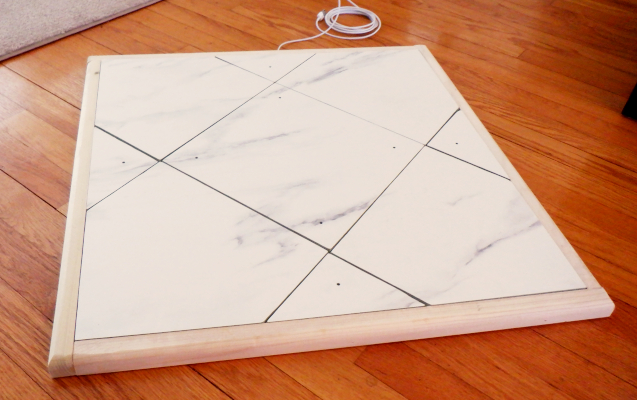
The Pubby Pad is a cross between a full-sized pad and a travel pad, and is designed to be cheap to manufacture and ship. It is made of engineered wood, and uses force-sensing resistors (FSR) for the sensors. They cost about $165, making them an excellent value for a hard pad. They're made and sold in batches from the USA, so you need to get on a waitlist if you want one.
¶ StepManiaX Stage
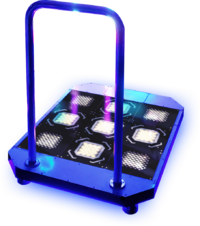
StepManiaX (SMX) stages are full-size pads built for arcade use (mainly for the game, StepManiaX). They saw a lot of demand earlier on due to being the most accessible purchase for a newly built full arcade pad. Older models use load cells and newer models (generations 4+) use force-sensing resistors (FSRs) as their sensor technology. SMX pads also come with a bar that is very wide and comfortable for taller players. The cost for these pads new is roughly $1900 shipped to the USA, but they sometimes trade hands used as well.
SMX pads are always in demand and they have very limited runs, so buying one can be a tedious process (they sometimes sell out in seconds), and drops for single stage purchase have become practically non-existent due to increased business with actual arcades. Recently, stock has only been available in single-digit quantities, at completely unannounced times (the mailing list for drops does not receive anything for these surprise stocks), so if you're still looking to purchase a standalone stage new then you'll have to visit the store site frequently. More recent builds have had inconsistencies in parts and may require more modding out of the box to bring to a playable point.
¶ DSPrototyping Wooden DDR Pad
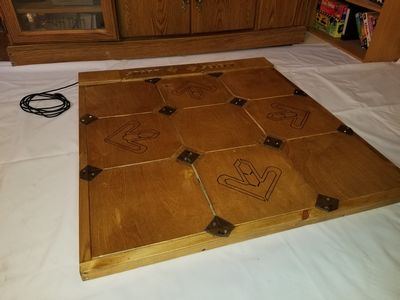
These are essentially metal contact type DDR pads built on a wooden frame, sold for $300 each. The non-input panels are glued to the frame while the arrow panels are kept in place with brackets and held apart from the contacts using springs. They've seen play at various anime and video game conventions and it is unclear whether they have seen use for any serious or enthusiast play.
¶ Pads that can only usually be found used
¶ DDR/ITG Arcade Pads
.jpg)
Arcade pads can be found with a cabinet or separate from it. These pads usually require the cabinet to operate but devices exist that can convert a pad's I/O to USB so it can plug into a regular computer, no longer requiring the cabinet.
Since these pads come from real arcade machines that are designed for arcade use, they are extremely robust and they are essentially overbuilt for home-use. They use arcade sensors but it's very common to see people upgrading them to FSRs, since it's very easy to do so and it's a "non destructive upgrade" (the FSRs can just sit on top of the existing parts without removing anything).
Arcade pads have literally been around the longest, so much is known about how to mod them.
Depending on what you use to connect your arcade pad(s) to your computer, you might run into USB polling issues. If your pad is only polling at 125hz, you can check out this guide if you're using Windows or this guide if you're using Linux.
Since the pandemic, the price of real arcade pads has skyrocketed. Lots of folks in the community bought full cabinets for under or around $1000, or single pads for $400 or less. But in recent years the demand for them has dramatically increased.
¶ Blue Shark
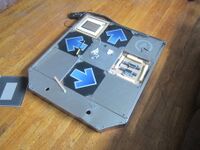
Blue Shark pads came out in the mid 2000s and provided one of the best home pads at the time. It uses 2 DDR-style rubber sensors per panel that were located in the center of the pad. The Blue Shark uses real 3/4 inch thick acrylic with designs printed on the back. Just like real DDR acrylic panels, the art tended to rub off at the contact points. All components are stapled onto a large sheet of MDF making it possible to move the sensors to the edges of each panel for better sensitivity. The pad itself came with a thin aluminum bar which is wobbly and unstable. The pad has select two contact-based buttons similar to old console pads.
¶ Cobalt Flux
Cobalt Flux (CF) pads were some of the best in-home pads you could buy back in the day. They aren't currently made anymore, but the word is a new Cobalt Flux Pro is in the works. These are similar in construction to LTEK pads, and can be penny-modded the same way.
CF pads require a control box to work with USB or other gaming consoles. Luckily, some parts can still be purchased new from Cobalt Flux directly.
DDRPad.com sells a kit for making your own "Cobalt Flux Style Pad", shown below under the “Options To Build” header.
¶ DDR Game
This gallery shows the internals of a DDRGame Energy pad.
¶ Precision Dance Pads
Precision Dance Pads (PDP) were lightweight pads made of polycarbonate, MDF, duct tape, velcro, and foil, with custom printed graphics available. They have a smooth top surface, which may be a benefit or a detriment depending on your playstyle. Some have reported the pad breaking over time, with worse results when playing on carpet. The pads were considered decent at the time, but nowadays there are better choices.
¶ Nijel Barkus' FSR pads
These are no longer available.
Nijel has started making pads primarily out of plywood and polycarbonate, similar to LTEK pads, except using force-sensing resistor (FSR) sensors instead of contact sensors. He makes a full-sized version and a travel pad sized version and sells them on his own website from Portland, OR. Both versions come with Start/Select buttons and 4 knobs to adjust the FSR thresholds with. His pads use regular Teensies like most DIY options and can therefore be flashed with a different FSR firmware if desired. The full-sized version also optionally comes with a bar, but this bar hasn't been tested by a player yet, although due to their similar size, most custom bar options for LTEKs work with this pad as well.
¶ Pads that are being developed but are not yet available
¶ Rhythm Horizon Platform
Previously named "Impulse Pads", Rhythm Horizon Platforms are a load-cell based pad that has been in development for years. It now is being run by the folks behind Rhythm Horizon (a 9-panel dance game similar to ITG). Not a lot is known about these pads as the project has gone on so long, but it's expected that they will ship without a bar, without lights, will use load cells, and the panels are slightly smaller than normal arcade pads.
For the latest news on this pad, you should check our Rhythm Horizon Discord's #rhythm-horizon-platform channel.
¶ Cobalt Flux Pro (new version)
Josh at Cobalt Flux mentioned they are working on a new version of their pad:
Thanks for reaching out. We are in fact working on releasing a new Cobalt Flux Platform! As you can probably imagine getting everything set up to manufacture pads at scale again is quite a long process. We know many people were hoping for the pads to be available this year, but unfortunately they won't be widely available until sometime in 2021.
It was slated to be a re-work of their original design, using similar contact sensors. They are aware of FSRs but had concerns about the software being too complicated for normal users, so they stuck with contact sensors. This pad was supposed to come out in 2021 but it has been delayed (and no further updates have been made as of 2024).
¶ Places to find used pads or arcade cabinets
¶ Marketplace Communities
¶ Japanese arcade game importers
Plenty of small companies (usually who do business on Facebook) import used cabinets from Japan in large containers.
¶ GAME SARU
Game Saru is a company based out of Reno, Nevada in the United States and sells imported rhythm game cabinets. This includes DDR machines which can be converted into ITG.
¶ Options to build
¶ Full-sized pads
¶ Mystic steps
The Mystic Steps pad is a DIY pad that uses arcade sensors.
¶ Dom's FSR pad
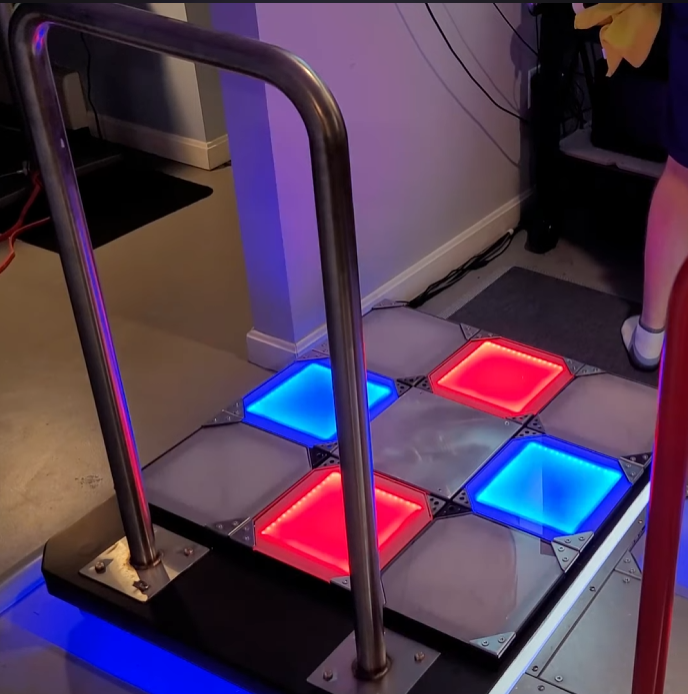
Dom made an 11 part video series showing the process of creating a full size FSR pad with arcade parts. The pad has a flat steel base with SMX prototype bars and uses real arcade switch frames.
¶ RE:Flex
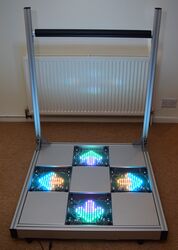
RE:Flex is an open source spec for a full-size dance pad based on load-cell sensor technology. All of the required components have part lists that can be ordered from local suppliers, and the PCBs have a step-by-step tutorial on how to order them. Most of the difficulty in the build is sourcing parts, assembly of the pad is straight-forward.
The aluminum extrusion frame provides a good base for building a sturdy pad. Some builds have swapped the sensors/PCBs with standard FSRs, which can be a good alternative during chip shortages or difficulties with sourcing.
The current version (version 2) has been built by multiple people, and version 3 is under development.
¶ Renbrandt's Puzzle Pad
Puzzle pad is kinda like full sized pad, but the idea is that you can quickly and easily assemble and disassemble it for traveling or for any other reason. The original design uses spare arcade parts, but the concept can be done without any of them. There is no proper guide for building one at this date, but the idea can be seen and copied from the announcement video.
¶ OpenPad

This is a fullsized pad made from wood and giant 200kg load cell beams. The design files and components are available on github. As with any load cell design (i.e. StepmaniaX Gen1-3) mounting the sensors themselves prove complicated as they require height for clearance and a type of actuation point that has mounting holes. As documented here, the sensors are also very localized and so, multiple load cells are desirable for coverage, which adds to complexity and costs.
¶ DDRPad.com's Cobalt Flux Style DIY Pad Kit
DDRPad.com offers a kit to make a "Cobalt Flux Style DIY Pad". They also provide a build guide with step-by-step pictures.
¶ Travel pads

Travel pads are pads that can be built using any material, and usually feature an arcade-sized center panel with long rectangular shaped panels. The very first Travel pad was build by Renbrandt in 2018, but the design was quickly iterated and improved by other players. Below are some great options and build guides for some travel pads.
¶ Teejusb Pad
The Teejusb pad is a low cost travel pad that is very lightweight (<10lbs) and requires 0 tools for maintenance, however they are needed to build. Check out the build guide if you want to build this yourself.
¶ Bandit's Travel Pad
Bandit's travel pad is built off of a 2x2 plywood board, and acrylic (or polycarbonate) panels held down by velcro. If you have very little electronics experience, a tight budget, or no access to tools but want a smaller sized pad, this is the pad for you.
¶ Widget Pad
Widgetpad is an FSR mini pad with lights made by Widget.
¶ Dom's Travel Pad
Dom made a travel pad out of arcade parts (using real arcade switch frames cut in half). In this video he discusses the planning and here is the actual build.
¶ Nato's Metal Pad
Nato made a travel pad out of 1x1" aluminum extrusion and acrylic panels. The BOM and build guide can be found on this github page.
¶ Nato's Ikea Cutting-board Pad
Nato also made a travel pad based on very cheap Ikea cutting boards. This pad does not need to be disassembled to fit in a carry-on suitcase.
¶ Nabulator's mini pad
Nabulator's mini pad is an FSR pad made of wood. Requires woodworking tools. Not a guide but more a reference build. This pad uses the long FSR strips with popsicle stick-like shims to help actuate the sensors. Because the actuation area is very narrow, the popsicle sticks need strict tolerance its thickness and length. square FSRs are more reliable when make adjustments and are easier to work with.
¶ Xeal's Folding Travel Pad
Xeal made a pad that folds for travel. It includes lights. Here are some more detailed photos.